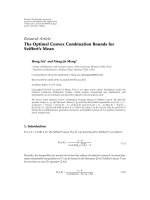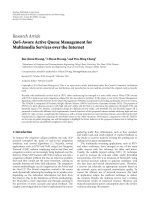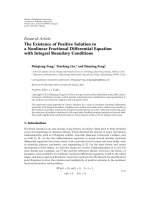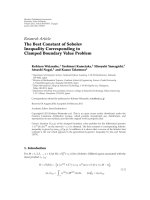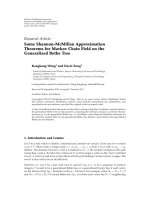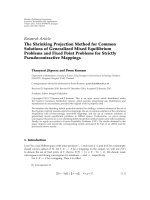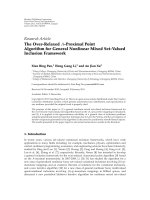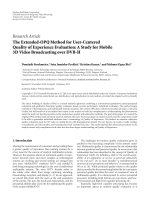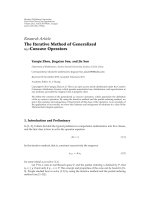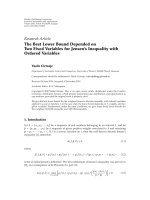Báo cáo hóa học: "Research Article The Waterfilling Game-Theoretical Framework for Distributed Wireless Network Information Flow" pptx
Bạn đang xem bản rút gọn của tài liệu. Xem và tải ngay bản đầy đủ của tài liệu tại đây (2.98 MB, 13 trang )
Hindawi Publishing Corporation
EURASIP Journal on Wireless Communications and Networking
Volume 2010, Article ID 482975, 13 pages
doi:10.1155/2010/482975
Research Article
The Waterfilling Game-Theoretical Framework for Distributed
Wireless Network Information Flow
Gaoning He,
1
Laura Cottatellucci,
2
and M
´
erouane Debbah
3
1
Research & Innovation Center, Alcatel-Lucent Shanghai Bell, 388 Ningqiao Road, Pudong, Shanghai 201206, China
2
Department of Mobile Communications, EURECOM, 06904 Sophia-Antipolis Cedex, France
3
Alcatel-Lucent Chair on Flexible Radio, 3 Rue Joliot-Curie, 91192 Gif sur Yvette, France
Correspondence should be addressed to Gaoning He,
Received 1 October 2009; Revised 13 May 2010; Accepted 2 July 2010
Academic Editor: Zhi Tian
Copyright © 2010 Gaoning He et al. This is an open access article distributed under the Creative Commons Attribution License,
which permits unrestricted use, distribution, and reproduction in any medium, provided the original work is properly cited.
We present a general game-theoretical framework for power allocation in the downlink of distributed wireless small-cell networks,
where multiple access points (APs) or small base stations send independent coded network information to multiple mobile
terminals (MTs) through orthogonal channels. In such a game-theoretical study, a central question is whether a Nash equilibrium
(NE) exists, and if so, whether the network operates efficiently at the NE. For independent continuous fading channels, we prove
that the probability of a unique NE existing in the game is equal to 1. Furthermore, we show that this power allocation problem can
be studied as a potential game, and hence efficiently solved. In order to reach the NE, we propose a distributed waterfilling-based
algorithm requiring very limited feedback. The convergence behavior of the proposed algorithm is discussed. Finally, numerical
results are provided to investigate the price of anarchy or inefficiency of the NE.
1. Introduction
Recently, there has been an increasing interest for small-cell
networks. In fact, they have been recognized as an effective
and low-cost architecture to provide wireless data rate access
to Internet users [1, 2]. These networks consist of numerous
and densely deployed APs, known as outdoor femto cells
or small-cells, connected to an existing backbone network
with heterogeneous links, for example, fibers, ADSLs, and
power lines. The general idea is to provide signal coverage
and high data rates in dense environments, that is, areas
with high user concentrations, by installing low-cost w ireless
access nodes and exploiting the existing heterogeneous wired
infrastructures without a new high-cost cabling. In reality,
the femto nodes may belong to different service providers
eventually organized in coalitions to maximize their own rev-
enues. In such a context, there is a critical tr ade-off between
cooperation and competition among different providers who
may share information and resources to maximize their
own revenues. In order to enable both cooperation among
providers and network scalability, the femto nodes need self-
organizing mechanisms to perform communications and
network control functions. Thus, distributed algorithms
accounting for the revenues of different providers play a key
role in this context.
In contrast to the legacy cell networks, in a small-cell
network a user may be served by more than one femto node.
This feature is strategic to cope with the heterogeneity of the
core network. In fact, if a user were only connected to a single
out-door femto-cell, it would suffer from low throughput
from time to time due to the limited-backhaul capacity,
despite the presence of a high-speed wireless link. As a result,
users would access simultaneously to different femto-cells in
order to aggregate the sum capacity of the backhaul links.
In this paper, we describe a smal l-cell network with
N MTs served simultaneously by M femto nodes over
N orthogonal channels, for example, FDMA, TDMA, and
OFDM. For such a system, and we study the power allocation
problem under the constraint of maximum transmit power
at each femto node (The issue of load balancing [3] in the
wired network, and how the di fferent packets are split with
respect to the backhaul capacity from a main decentralized
scheduler, although important, is not investigated in this
paper. We assume that perfect load balancing holds). T his
2 EURASIP Journal on Wireless Communications and Networking
system is substantially different from the ones typically
analyzed in literature. In fact, it does not reduce to a classical
downlink of a cellular network modeled as a broadcast
channel since there are several APs transmitting information
simultaneously to the same MT. Nor does it reduce to N
independent multiple access channels when considering each
mobile as a receiver because of the power constraints at
the APs. Finally, the considered system does not reduce
to a multicellular or an adhoc network modeled as an
interference channel since all the signals received at each MT
carry useful information to be decoded. In this paper we
assume that each signal of interest is decoded considering the
remaining signals as interference. This scheme is susceptible
to improvement by joint decoding of all the received signals.
However, this decoding approach exceeds the scope of this
paper.
In traditional wireless cellular networks, the power
allocation is often implemented w i th centralized algorithms
aiming at maximizing the sum of the Shannon transmission
rate [4]. The maximization problem is solved by waterfill-
ing algorithms [5–8] extended to multiuser contexts. The
optimization is in general nonconvex but algorithms that
reach local maximum are available [9–11]. Such a centralized
power control scheme usually requires a unique shared
resource allocation controller and complete channel state
information (CSI) with consequent feedback and overhead.
It is worth noting that this overload scales exponentially
with the number of transmitters and receivers. T hus, such
a fully centralized approach is not suitable for small-cell net-
works without centralized devices and with multiple service
providers interested in their own revenues. Additionally, it is
not scalable in dense networks.
Game theory [12]providesapossibleanalyticalframe-
work to develop decentralized and/or distributed algorithms
for resource allocation in the context of interacting entities
having eventually conflicting interests. Recently, nonco-
operative game theory and its analytical methodologies
have been widely applied in wireless systems to solve
communication control problems [13]. Distr i buted power
allocation algorithms based on noncooperative games have
been proposed for uplink single cell systems, that is, multiple
access channels, and downlink multicellular networks or ad
hoc networks, that is, interference channels. In [14], general
results on potential games are provided and sp ecialized to an
uplink single-cell system with multiple access channel based
on code division multiple access (CDMA). In [15], a digital
subscriber line (DSL) is modeled as a multiple access system
based on an OFDM scheme and an iterative waterfilling
algorithm is proposed along the lines of the results in [16].
The classical uplink single-cell scenario is relaxed in [17]to
include a jammer in the system and an iterative waterfilling
algorithm is proposed.
In [16], power allocation on the interference channel is
modeled as a noncooperative game, and the conditions for
the existence and uniqueness of Nash equilibrium (NE) are
established for a two-player version of the game. Similar
conditions for the existence and uniqueness have been
extended to the multiuser case in [18], where the authors
focus on the practical design of distributed algorithms to
compute the NE and propose an asynchronous iterative
waterfilling algorithm for an interference channel. In [9],
the so-called symmetric waterfilling game was studied.
The authors assume that for a set of subchannels and
receivers the channel gains from all transmitters are the
same. The game is shown to have an infinite number of
equilibria. The framework of the interference channel has
been relaxed in [19] to include cognitive radio systems with
transmitters and receivers equipped with multiple antennas,
that is, multiple input multiple output (MIMO) systems. A
distributive algorithm for the design of the beamformers at
each secondar y transmitter based on a noncooperative game
is developped. Uniqueness and global stability of the Nash
equilibrium are studied. Finally, it is worth to note that the
DSL power allocation game in [15] is similar to our game
from the mathematical point of view. However, it can be
shown that with DSL crosstalk link channel coefficients the
game in [15] is not a potential game. Therefore, in general, all
the nice properties from potential games do not necessarily
hold in their case.
In this paper, we adopt game-theoretical methodolog ies
for power allocation problem in the downlink of small-cell
networks (Note that a similar power allocation g ame can
be considered for the uplink where MTs are the players
taking decisions. However, it is impractical for MTs to have
complete uplink CSI. Then, realistic models should take
into account the assumption of knowledge reduction at
the transmitters. The interested readers are referred to [20]
fortheframeworkofBayesiangames).Wemodelfemto
cells of different operators as players who adaptively and
rationally choose their transmission strategies, that is, their
transmit power levels, with the aim of maximizing their own
transmission sum-rates under maximum power constraints.
We first consider the case where each femto cell decides its
own power allocation based on the assumption of complete
CSI. Later we remove this assumption, and we show that
the same equilibrium can still be reached. In such a context
it is important to characterize the NE set, for example, the
existence and uniqueness of NE. This aspec t plays a key role
for the application of a distributed game-theoretical-based
algorithm. In fact, the existence and uniqueness of an NE
guarantees a predictable power allocation and the behavior
of a self-org anizing network. An answer to this relevant
issue depends strongly on the channel fading statistics and
the number of players of the investigated channel setting,
as is apparent from the comparison of the results in [9–
11]. We show that, for a quasi-static fading channel (a
fading channel is quasi-static if it is constant during the
transmission of a codeword but it may change from a
codeword to the following one) with continuous probability
density functions of the channel power attenuations, an NE
exists and is unique with unit probability. Additionally, we
point out that the considered game is a potential game
and a simple decentralized algorithm based on the best-
response algorithm can be readily proposed. However, a
straightforward decentralized algorithm based on complete
CSI would not be scalable since the required overhead would
scale exponentially with the number of transmitters and
receivers. Then, we propose a distributed iterative algorithm
EURASIP Journal on Wireless Communications and Networking 3
AP 1
AP 2
Femto-ce
l
l
group
Internet
Figure 1: Illustration of femto-cell group with distributed network
information flow.
which requires the transmission of the total received power
at each MT at each iteration step. With this distributed
algorithm, the overhead scales only linearly with the number
of receivers. The convergence rate of the proposed algorithm
is analyzed. The price of anarchy is also investigated by
numerical analysis.
The paper is organized as follows. In Section 2 ,we
introduce the system model and formulate the problem.
In Section 3, we study the existence and uniqueness of
NE and characterize the NE set. In Section 4, we show
that the game at hand is a potential game. Based on the
property of potential games and observations on the required
information, we propose a distributed algorithm converging
to the NE. We investigate the convergence issue. Numerical
analysis of the price of anarchy and the convergence rate
are provided in Section 5. Section 6 concludes the paper by
summarizing the main results and insig hts on the system
behaviour acquired in this work.
2. System Model and Problem Statement
2.1. MultiSource MultiDest ination System Model. We con-
sider a wireless system in downlink with M noncooperative
APs simultaneously sending information to N MTs over
N orthogonal channels, for example, different time slots,
frequency bands, or groups of subcarriers in time division
multiple access (TDMA), frequency division multiple access
(FDMA), or OFDM systems, respectively, as shown in
Figure 2. Each channel is preassigned to a different MT by a
scheduler and each MT receives signals only on the assigned
channel. Without loss of generality, throughout this paper we
assign channel n to MT n,forn
= 1, , N. This implies
that both the MT set and the channel set share the same
index in our model. Note that the system model at hand does
Subcarrier
AP 1 AP 2
AP M
MT 1 MT 2
MT N
12
N
···
···
···
Figure 2: The multiuser OFDM model.
not reduce to a classical multiple access channel, a broadcast
channel, or an interference channel [6].
We assume that the channels are block fading (in differ-
ent scientific communities these channels are also referred to
as quasi-static fading or delay constrained channels), that is,
the fading coefficients are constant during the transmission
of a codeword or block. Within a given transmission block,
let G
∈ R
M×N
++
be the channel gain matrix whose (m, n)entry
is g
m,n
, the channel gain of the link from AP m to MT n
on the preassigned channel n.ThematrixG is random with
independent entries. We further assume that the distribution
function of each positive entry g
m,n
is a continuous function.
By assuming that the MTs use low-complexity single-
user decoders [6], the signal-to-interference-plus-noise-ratio
(SINR) of the signal from AP m received at MT n is given by
γ
m,n
=
g
m,n
p
m,n
σ
2
+
M
j=1, j
/
= m
g
j,n
p
j,n
,(1)
where p
m,n
is the power transmitted from AP m on
subchannel n,andσ
2
is the variance of the white Gaussian
noise. For AP m, write the maximum achievable sum-rate as
[6]
R
m
=
N
n=1
log
1+γ
m,n
, ∀m,
(2)
and the power constraint as
N
n=1
p
m,n
≤ P
max
m
, ∀m,
(3)
where P
max
m
is maximum transmit power of AP m and P
max
m
>
0, for all m.
2.2. Power Allocation as a NonCooperative Game. Here, we
introduce the power allocation problem as a noncooperative
4 EURASIP Journal on Wireless Communications and Networking
strategic game. Because of the competitive nature of the
APs, belonging in general to different service providers, AP
m aims to maximize its own transmission rate R
m
(2)by
choosing its transmit power vector p
m
[p
m,1
, , p
m,N
]
T
,
subject to its power constraint (3). Denote by vector p
=
[p
T
1
, , p
T
M
]
T
the outcome of the game in terms of transmit
power levels of all M APs on the N channels. We can
completely describe this noncooperative power allocation
game as
G
[
M,
{P
m
}
m∈M
, {u
m
}
m∈M
], (4)
where the elements of the game are
(i) Player set: M ={1, , M};
(ii) Str ategy set:
{P
1
, , P
M
}, where the strategy set of
player m is
P
m
=
⎧
⎨
⎩
p
m
: p
m,n
≥ 0, ∀n,
N
n=1
p
m,n
≤ P
max
m
⎫
⎬
⎭
;(5)
(iii) Utility or payoff function set:
{u
1
, , u
M
},with
u
m
p
m
, p
−m
=
N
n=1
log
1+
g
m,n
p
m,n
σ
2
+
j
/
= m
g
j,n
p
j,n
=
R
m
,
(6)
where p
−m
denotes the power vector of length (M −
1)N consisting of elements of p other than the mth
element, that is,
p
−m
=
p
T
1
, , p
T
m
−1
, p
T
m+1
, , p
T
M
T
.
(7)
In such a noncooperative game setting, each player m
acts selfishly, aiming to maximize its own payoff,given
other players’ strategies and regardless of the impact of its
strategy may have on other players and thus on the overall
performance. The process of such selfish behaviors usually
results in Nash equilibrium, a common solution concept for
noncooperative games [21].
Definition 1. A power strategy profile p
is a Nash equilib-
rium If, for every m
∈ M,
u
m
p
m
, p
−m
≥
u
m
p
m
, p
−m
,
(8)
for all p
m
∈ P
m
.
From the previous definition, it is clear that an NE simply
represents a particular “steady” state of a system, in the
sense that, once reached, no player has any motivation to
unilaterally deviate from it. The powers allocated in our
system correspond to an NE.
3. Characterization of Nash Equilibrium Set
In many cases, an NE results from learning and evolution
processes of all the game participants. Therefore, it is fun-
damental to predict and characterize the set of such points
from the system design perspective of wireless networks. In
the rest of the paper, we focus on characterizing the set of
NEs. The following questions are addressed one by one.
(i)DoesanNEexistinourgame?
(ii) Is the NE unique or there exist multiple NE points?
(iii) How to reach an NE if it exists?
(iv) How does the system perform at NE?
Throughout this section we investigate the existence and
uniqueness of a Nash equilibrium.
It is known that in general an NE point does not
necessarily exist. In the following theorem we establish the
existence of a Nash equilibrium in our game.
Theorem 1. A Nash equilibrium exists in game G.
Proof. Since P
m
is convex, closed, and bounded for each
m; u
m
(p
m
, p
−m
) is continuous in both p
m
and p
−m
;and
u
m
(p
m
, p
−m
)isconcaveinp
m
for any set p
−m
, at least one
Nash equilibrium point exists for G [12, 22].
Once existence is established, it is natural to consider
the characterization of the equilibrium set. The uniqueness
of an equilibrium is a rare but desirable property, if we
wish to predict the network behavior. In fact, many game
problems have more than one NE [12]. As an example of
games with infinite NEs, we could consider a special case
of our game G, namely, the symmetric waterfilling game [9]
where the channel coefficients are assumed to be symmetric.
Then, in general, our game G does not have a unique NE.
But with the assumption of independent and identically
distributed (i.i.d.) continuous entries in G, we will show that
the probability of having a unique NE is equal to 1.
For any player m, given all other players’ strategy profile
p
−m
, the best-response power strategy p
m
can be found by
solving the following maximization problem:
max
p
m
u
m
p
m
, p
−m
s.t.
N
n=1
p
m,n
≤ P
max
m
p
m,n
≥ 0, ∀n
(9)
which is a convex optimization problem, since the objective
function u
m
is concave in p
m
and the constraint set is convex.
Therefore, the Karush-Kuhn-Tucker (KKT) conditions for
optimization are sufficient and necessary for the optimality
[5]. The KKT conditions are derived from the Lagrangian for
each player m,
L
m
p, λ, ν
=
N
n=1
log
1+
g
m,n
p
m,n
σ
2
+
j
/
= m
g
j,n
p
j,n
−
λ
m
⎛
⎝
N
n=1
p
m,n
− P
max
m
⎞
⎠
+
N
n=1
ν
m,n
p
m,n
(10)
EURASIP Journal on Wireless Communications and Networking 5
and are given by
g
m,n
σ
2
+
M
j
=1
g
j,n
p
j,n
− λ
m
+ ν
m,n
= 0, ∀n,
(11)
λ
m
⎛
⎝
N
n=1
p
m,n
− P
max
m
⎞
⎠
=
0, (12)
ν
m,n
p
m,n
= 0, ∀n,
(13)
where λ
m
≥ 0, ν
m,n
≥ 0, for all m and for all n are dual
variables associated with the power constraint and transmit
power positivity, respectively. The solution to (11)–(13)is
known as waterfilling [6]:
p
m,n
=
1
λ
m
−
σ
2
+
j
/
= m
g
j,n
p
j,n
g
m,n
+
, ∀n,
(14)
where (x)
+
max{0, x} and λ
m
satisfies
N
n=1
1
λ
m
−
σ
2
+
j
/
= m
g
j,n
p
j,n
g
m,n
+
= P
max
m
.
(15)
In order to analyze the equilibrium set, we establish
necessary and sufficient conditions for a point being an NE
in the game G.
Theorem 2. Apowerstrategyprofile
{p
1
, , p
M
} is a Nash
equilibrium of the game G if and only if each player’s power
p
m
is the single-player wate rfilling result (9) while treating
other players’ signals as noise. The corresponding necessary and
sufficient conditions are:
g
m,n
σ
2
+
M
j=1
g
j,n
p
j,n
− λ
m
+ ν
m,n
= 0, ∀m ∀n,
(16)
λ
m
⎛
⎝
N
n=1
p
m,n
− P
max
m
⎞
⎠
=
0, ∀m, (17)
ν
m,n
p
m,n
= 0, ∀m ∀n.
(18)
The proof can be found in Appendix A.
From (16), it is easy to verify that necessarily λ
m
> 0, since
ν
m,n
≥ 0andg
m,n
> 0, for all m and for all n. Also, from (17),
we have
N
n=1
p
m,n
= P
max
m
, ∀m.
(19)
This equation implies that, at the NE, all APs transmit at their
maximum power by conveniently distributing the power
over all the orthogonal channels.
However, it is still difficult to find an analytical solution
from (16)–(18), since the system consisting of (14)and(15)
is nonlinear. To simplify this problem, we could consider
linear equations instead of nonlinear ones. The following
lemma provides a key step in this direction.
Lemma 1. For any realization of channel matrix G, there exist
unique values of the Lagrange dual variables λ and ν for any
Nash equilibrium of the game G. Furthermore, there is a unique
vector s
= [s
1
, , s
n
]
T
such that any vector p corresponding to
a Nash equilibrium satisfies
M
m=1
g
m,n
p
m,n
s
n
, ∀n.
(20)
TheproofcanbefoundinAppendix B.
Now, let Z be the following (M + N)
× MN matrix:
Z
=
⎡
⎢
⎢
⎢
⎢
⎢
⎢
⎢
⎣
I
M
I
M
··· I
M
g
T
1
0
T
M
··· 0
T
M
0
T
M
g
T
2
··· 0
T
M
.
.
.
.
.
.
.
.
.
.
.
.
0
T
M
0
T
M
··· g
T
N
⎤
⎥
⎥
⎥
⎥
⎥
⎥
⎥
⎦
(M+N)×MN
,
(21)
where g
n
is the nth column of G, I
M
is the M × M identity
matrix, and 0
M
is the zero vector of length M.Letc be the
following vector of length M + N:
c
=
P
max
1
P
max
2
···P
max
m
s
1
s
2
···s
N
T
. (22)
Then, (19)and(20) can be written in the form of linear
matrix equation
Zp
= c
. (23)
Define the following sets:
X
(
m, n
)
: ν
m,n
= 0
,
N
{n : ∃m such that
(
m, n
)
∈ X},
(24)
and denote by
|X| and |N | their cardinalities. From (18), if
an index (m, n)
/
∈ X we must have p
m,n
= 0. Without loss of
generality, we assume that N
={1, ,
N} for
N ≤ N.Let
Z
be the (M+
N)×M
N matrix formed from the first M+
N rows
and first M
N columns of Z, p is formed from the first M
N
elements of p,and
c is formed from the first M +
N elements
of c. Then, any NE solution must satisfy
Z
p
= c.
(25)
Let
Z be the (M +
N) ×|X| matrix formed from the
columns of
Z that correspond to the elements of X. Similarly,
let p be the vector of length
|X| with entries p
m,n
such that
(m, n)
∈ X (same order as they were in p). Then, any NE
solution satisfies
Zp = c.
(26)
Lemma 2. For any realization of a random M
× N channel
gain matrix G with i.i.d. continuous entr ies, if M
N>M+
N,
the probability that
|X|≤M +
N is equal to 1.
Lemma 3. (1)IfM
N>M+
N and |X|≤M +
N,the
probability that rank(
Z) =|X| is equal to 1.
(2)IfM
N ≤ M +
N, the probability that rank(
Z) = M
N
is equal to 1.
6 EURASIP Journal on Wireless Communications and Networking
The proofs of Lemmas 2 and 3 can be found in
Appendices C and D,respectively.
Based on Lemmas 1, 2,and3, we derive the following
theorem.
Theorem 3. For any realization of a random M
× N channel
gain matrix G with statistically independent continuous
entries, the probability that a unique Nash equilibrium exists
in the game G is equal to 1.
The proof can be found in Appendix E.
Thus, from Theorems 1 and 3, we have established the
existence and uniqueness of NE in our game G.
4. Distributed Power Allocation and Its
Convergence to the Nash Equilibrium
An equilibrium has practical interests only if it is reachable
from nonequilibria states. In fact, there is no reason to
expect a system to operate initially at e quilibrium. The
convergence of an algorithm to an equilibrium is in general
a very hard problem usually related to the specific algorithm
and requiring the analysis of synchronous or a synchronous
update mechanisms (for power allocation algorithms in
interference channels see [18, 23]).
4.1. Potential Game Approach. Fortunately, our game G can
be studied as a potential game (The notation of potential
games was firstly used for games in strategic form by
Rosenthal (1973) [24], and later generalized and summarized
by Monderer (1996) [25]). Potential games are known to
have appealing properties for the convergence of the best-
response or greedy algorithms to the equilibrium. All the
potential games admit a potential function.Thispotential
function is a unique global function that all the players
optimize when they optimize their own utility functions.
Thus, the set of pure Nash equilibria can be found by
simply locating the local optima of the potential function.
Such games have received increasing attention recently in
wireless networks [14, 26, 27], since the existence of potential
function enables the design of fully distributed algorithms
for resource allocation problems. In fact, there are various
notions of potential games such as exact potential, weighted
potential, ordinal potential, generalized ordinal potential,
pseudo potential, and so forth. These potential games
could possess slightly different properties for the existence
and convergence of NE. Here, we consider only the exact
potential games, since they are closely related to our game.
Exact potential games are defined in the following statement.
Definition 2. AstrategicgameG is an exact p otential game if
there exists a function v : P
→ R satisfying
v
p
m
, p
−m
−
v
q
m
, p
−m
=
u
m
p
m
, p
−m
− u
m
q
m
, p
−m
, ∀m,
(27)
for all (p
m
, p
−m
), (q
m
, p
−m
) ∈ P .Thefunctionv is referred
to as exact potential of the game.
Equation (27) implies that the NE of the original game
G must coincide with the NE of the potential game, which
is defined as a new game with v as an identical utility
function for all the players. Therefore, we can transform the
noncooperative strategic game G into a potential game, if we
can find a potential function that quantifies the variation in
terms of utility due to unilateral perturbation of each player’s
strategy, as indicated in (27).
Taking inspiration from the result derived in the single
channel case [14], we have the following lemma.
Lemma 4. The game G is an exact potential game with the
following potential function:
v
p
m
, p
−m
=
N
n=1
log
⎛
⎝
σ
2
+
M
m=1
g
m,n
p
m,n
⎞
⎠
=
N
n=1
log
⎡
⎢
⎢
⎢
⎢
⎢
⎢
⎣
g
m,n
p
m,n
+
⎛
⎝
σ
2
+
j
/
= m
g
j,n
p
j,n
⎞
⎠
aggregate interference + noise
⎤
⎥
⎥
⎥
⎥
⎥
⎥
⎦
.
(28)
Proof. From (28)and(6), we observe that the first deriva-
tives of v
and u
m
are equal, that is,
∂v
∂p
m
=
∂u
m
∂p
m
=
N
n=1
g
m,n
σ
2
+
N
j
=1
g
j,n
p
j,n
, ∀m
(29)
which implies that the property of exact potential (28)is
satisfied. This completes the proof.
We denote by ζ
m,n
the term (σ
2
+
j
/
= m
g
j,n
p
j,n
)which
stands for the aggregate interference plus noise of user m
on subchannel n. In order to find user m’s single-user best-
response in the potential game, one needs to solve the
following maximization problem:
max
p
m
v
p
m
, p
−m
⇐⇒ max
p
m
N
n=1
log
ζ
m,n
+ g
m,n
p
m,n
s.t.
N
n=1
p
m,n
≤ P
max
m
p
m,n
≥ 0, ∀n.
(30)
Note that the problem (30) can be solved as a con-
vex optimization, when the private channel g ain g
m
=
{
g
m,1
, , g
m,N
} and the aggregate interference plus noise
ζ
m
={ζ
m,1
, , ζ
m,N
} are b oth known to player m.Itis
easy to verify that this single-user best-response is the same
waterfilling solution expressed in (14), due to the property of
potential function.
4.2. Distributed Algorithm and Convergence Property. Note
that if each AP has complete CSI, that is, knowledge
of the channel g ain matrix G,definedasinSection 2,
EURASIP Journal on Wireless Communications and Networking 7
the uniqueness of the NE guaranties that each AP can
determine independently the power allocation at the NE
in a decentralized manner. In order to acquire information
about the whole matrix G at each AP, a feedback channel
is usually needed to transmit the channel estimations from
MTs to APs. With this information, each AP can solve locally
the system of equations (16)–(18) or perform locally a best-
response algorithm based on the repeated maximization of
problem (30) by starting from a random point p
−m
∈
j
/
= m
P
j
. However, the structure of problem (30) suggests
an alternative distributed approach to reduce eventually the
signalling on the feedback channel. In fact, the repeated
optimization of problem (30)canbeperformedina
distributed way by feeding back at each AP m only the private
channel gain g
m
and the aggregate interference plus noise ζ
m
.
Nevertheless, note that such a distributed implementation of
the algorithm would lead to a transition phase where the
APs are not transmitting at an equilibrium point. In our
numerical results, we ignore the cost of feedback, and we
focus on analyzing the theoretical upper-bound.
The above discussion yields a simple algorithm based on
the iterative waterfilling [28] detailed in the following.
In this algorithm, we assume that the same game could be
myopically played repeatedly: in each round, every myopic
player (a myopic player has no memory of past game-
rounds) chooses its best-response according to the single-
player waterfilling that depends on the current state of the
game. The following theorem shows the convergence and
optimality of the algorithm.
Theorem 4. The DPIWF algor ithm converges to a unique
Nash equilibrium of the noncooperative game G.
The proof can be found in Appendix F.
A more general discussion about the convergence and
stability properties of potential games can be found in [25,
29]. In [25], it shows that every bounded potential game (a
game is called a bounded game if the payoff functions are
bounded) has the approximate finite improvement property
(AFIP), that is, for every
> 0, every -improvement path is
finite. Then, it is obvious that every such finite improvement
path of the exact potential games terminates in an
-
equilibrium point (an
-equilibrium is a strategy profile that
approximately satisfies the condition of Nash equilibrium).
In other words, the sequential best-response (players move in
turn and always choose a best-response) converges to the
-
equilibrium independent of the initial point. Note that this
is a very flexible condition for the convergence, since order
of playing can be deterministic or random and need not to be
synchronized. It is one of the most interesting properties of
the potential games, especially in order to distributively find
the equilibrium in self-organizing systems. In [29], it shows
that potential games are characterized by strong stability
properties (Lyapunov stable, see its definition in Theorem
5.34 of [29]). Also note that if the game has a unique NE,
then it is globally stable.
In the simultaneous best-response algorithm all the players
choose their best-responses simultaneously at each iteration.
It is not difficult to verify that, in the general case, it
does not necessarily converge, due to the “ping-pong” effect
generated by myopic players. However, [30] has shown that
for infinite pseudopotential games, a general class of games
including also exact potential games, with convex strategy
space and single-valued best-response (games with strictly
multiconcave potential, concave in each players’ unilateral
deviation, have single-valued best-response), the sequence of
simultaneous best-responses, reminiscent of fictitious play,
also converges to the equilibrium.
It is interesting to note that for many practical systems
with finite transmit power states, similar results still hold for
the convergence of the sequential best-response. The only
difference is that, in the finite case, the existence of exact
potential funct ion implies the finite improvement property
(FIP), and therefore, the sequential best-response converges
to the exact NE instead of an
-equilibrium.
Although the final convergence of the DPIWF algorithm
is proved, one may wonder whether the optimum of
the potential function (28) coincides with the optimum
social welfare, that is, the optimal total information rate
transmitted in the network. We discuss the price of anarchy
in the following section.
5. Numerical Evaluation
In this part, numerical results are provided to validate our
theoretical claims and assess the price of anarchy, that is, the
performance loss in terms of the transmit sum-rate of all APs
in the network due to a noncooperative game compared to
the maximum social welfare. We denote this transmit sum-
rate in the network as the actual total network rate, and
defined it as
u
p
=
M
m=1
u
m
p
.
(31)
We consider frequency-selective fading channels with
channel matrix G of size M
× N,whereM is the total
number of transmitters (players) and N is the total number
of receivers. We assume that the Rayleigh fading channel gain
g
m,n
are i.i.d. among players and channels. The maximum
power constraint for each player m is assumed to be identical
and normalized to
P
m
= 1.
In Figure 3, we show the convergence behaviors of
potential function and the actual total network rate, shor tly
referred to as “actual rate”, by using the proposed DPIWF
algorithm for a random channel realization. We set the
number of transmitters to M
= 10 and the number of
receivers to N
= 10. As expec ted, in both Figures 3(a) and
3(b) the potential function converges rapidly (at the 4th
iteration). In Figure 3(a), the actual rate converges slightly
slower (at the 6th iteration) and maintains a monotonically
increasing slope. However, in Figure 3(b), the actual rate
finally converges, but unfortunately it does not increase
monotonically and it converges only at the 34th iteration
with a convergence rate much slower than the potential
function. Note that we use this example to show that a
“defective” convergence may happen during the iteration
steps.
8 EURASIP Journal on Wireless Communications and Networking
initialize t = 0, p
(0)
m,n
= 0, ∀m ∀n
repeat
t
= t +1
for m
= 1toM do
for n
= 1toN do
ζ
(t)
m,n
= σ
2
+
j
/
= m
g
j,n
p
(t)
j,n
end for
[p
(t+1)
m,1
, , p
(t+1)
m,N
] = arg max
p
m
≥0
n
p
m,n
≤P
m
n
log(ζ
(t)
m,n
+ g
m,n
p
m,n
)
end for
until convergence
Algorithm 1: DPIWF algorithm.
0
10 20 30 40
50
15
20
25
30
35
40
45
Iterations
Total network rate (bits/s)
Actual rate
Potential
(a) An example of “ideal” convergence
0 1020304050
20
22
24
26
28
30
32
34
36
38
40
Iterations
Total network rate (bits/s)
Actual rate
Potential
(b) An example of “defective” convergence
Figure 3: Convergence and performance of potential function and actual total network rat.
In order to measure the performance efficiency of
distributed networks operating at the unique NE, we provide
here the optimal centralized approach as a target upper-
bound for the total network rate. We ignore the per formance
loss caused by the necessary uplink and downlink signalling
transmission. The total network rate maximization problem
can be formulated as
max
p
u
p
s.t.
n
p
m,n
≤ P
m
, ∀m
p
m,n
≥ 0, ∀m ∀n.
(32)
The optimization problem (32)isdifficult to solve since the
objective function is nonconvex in p. However, a relaxation
of this optimization problem [11] can be considered as a
geometric programming problem [31]. As well known, a
geometric programming can be transformed into a convex
optimization problem and then solved in an efficient way. A
low-complexity algorithm was proposed in [11] to solve the
dual problem by updating dual variables through a gradient
descent. Note that the algorithm always converges, but may
converges to a local maximum point in a few cases. We use
this algorithm in our simulations.
In the following part, we address two main practical
questions through numerical results.
(1) How does the network performance behave in aver-
age at the unique NE in comparison to the global
optimal solution or global welfare? More precisely, we
are interested in comparing the average total network
rate instead of the instantaneous total network rate.
We de no te by
u(M, N) the average total network rate
for a M transmitters and N receivers system, that is,
u
(
M, N
)
= E
G
⎡
⎣
M
m=1
N
n=1
log
1+
p
m,n
g
m,n
σ
2
+
j
/
= m
p
j,n
g
j,n
⎤
⎦
,
(33)
EURASIP Journal on Wireless Communications and Networking 9
0 5 10 15 20 25
0
10
20
30
40
50
60
70
80
90
M - total number of transmitters
N
= 15 (centralized)
N
= 15 (decentralized)
N
= 10 (centralized)
N
= 10 (decentralized)
N
= 5 (centralized)
N
= 5 (decentralized)
Total network rate (bps/Hz)
(a) σ
2
= 0.1
0 5 10 15 20 25
0
5
10
15
20
25
30
35
40
45
Total network rate (bps/Hz)
M - total number of transmitters
N
= 15 (centralized)
N
= 15 (decentralized)
N
= 10 (centralized)
N
= 10 (decentralized)
N
= 5 (centralized)
N
= 5 (decentralized)
(b) σ
2
= 1
Figure 4: Average total network rate, decentralized versus centralized optimality.
0 5 10 15 20 25
0.982
0.984
0.986
0.988
0.992
0.994
0.996
0.998
1.002
0.99
1
Probability of convergence within 5 iterations
M - total number of transmiters
N
= 5
N = 10
N
= 15
(a) σ
2
= 0.1
0 5 10 15 20 25
0.984
0.986
0.988
0.992
0.994
0.996
0.998
1.002
0.99
1
Probability of convergence within 5 iterations
M - total number of transmiters
N
= 5
N = 10
N
= 15
(b) σ
2
= 1
Figure 5: Probability of convergence within 5 iterations.
(2) What about the convergence behavior for the actual
total network rate when using DPIWF algorithm?
Does it converge as rapidly as in Figure 3(a) for the
most of the cases?
Let us consider the first question. In Figure 4,wecompare
the average total network rate of both decentralized and
centralized networks for two different channel noise levels
σ
2
= 0.1 and 1, respectively. The plots are obtained
through Monte-Carlo simulations over 10
4
realizations for
the channel gain matrix G. Figures 4(a) and 4(b) show the
total network rate as a function of the number of transmitters
M for different number of receivers N. More specifically ,
N
= 5, 10,15. We note that in both Figures 4(a) and 4(b), the
10 EURASIP Journal on Wireless Communications and Networking
centralized optimal approach always outperforms the decen-
tralized noncooperative algorithm. Additionally, for a fixed
number of transmitters N, when we increase the number of
receivers M, the performance loss of decentralized systems
compared to the centralized social welfare becomes greater
and greater. This phenomenon can be intuitively understood
as follows: when there is a great number of selfish players, the
hostile competition turns the multiuser communication system
into an interference-limited environment, where interference
significantly degrade the performance efficiency.
In Figure 4, we also note that for a fixed N the average
performance of centralized systems is an increasing function
of M, and the average performance of decentralized systems
corresponding to NE reaches a maximum and then decreases
flatting out. For the typical values of N, that is, N
= 5, 10,15,
in Figure 4(a), when σ
2
= 0.1 the average performance
of decentralized systems are maximized at M
= 4, 9, 14,
respectively; in Figure 4(b), when σ
2
= 1 the average
performance of decentralized systems are maximized at M
=
6, 11, 16, respectively. This comparison simply shows that
different noise variance (in general channel condition) have
adifferent impact on the decentralized system performance.
This observation is fundamental for improving the spectral
efficiency of a distributed multiuser small cell networks: For
a given ar ea, that i s, a given number of receivers N and given
channel c onditions, there exists an optimal number of access
points, denoted as M
, to be installed in the networ k. Roughly
speaking, when M>M
, the system is saturated due to
the increasing competition for the shared limited resources;
when M<M
, the system op erates in a unsaturated state,
since system resources are not fully exploited.
Let us now consider the second question. In Figure 5,
we show the probability of convergence to the NE within 5
iterations for σ
2
= 0.1 and 1, respectively. To be more precise,
we say that the algorithm converges at the fifth iteration if
the total network rate exceeds 99% of the rate at the NE.
We find that the probability of convergence is satisfactory.
It is greater than 0.982 in all cases and tends to 1 when
M
N and M N. Another interesting observation
is that the minimal convergence probability always occurs
when M
= N, regardless of the noise value σ
2
.
6. Conclusions and Future Works
In this paper, we study the power allocation problem in the
wireless small-cell networks as a strategic noncooperative
game. Each transmitter (AP) is modeled as a player in the
game who decides, in a distributed way, how to allocate its
total power through several independent fading channels.
We studied the existence and uniqueness of NE. Under the
condition of independent continuous fading channels, we
showed that the probability of having a unique equilibrium is
equal to 1. The game at hand is shown to be a potential game.
A distributed algorithm requiring very limited feedback
has been proposed based on the potential game analysis.
The convergence and stability issues have been addressed.
Numerical studies have shown that the DPIWF algorithm
can converge rapidly within 5 iterations with very high
probability.
Appendices
A. Proof of Theorem 2
Proof. We prove the necessary and sufficient parts separately.
(1) Proof of necessary condition (the only if part). From the
definition of NE (Definition 1), if a power set
{p
m
} is
an NE, it must satisfy all the best-response conditions
in (8) simultaneously. Suppose a situation that all
the players’ power except player m’s power reaches
the NE point:
{p
1
, , p
m
−1
, p
m
, p
m+1
, , p
M
}.In
this case when all other p layers’ powers are fixed, as
shown in (9), the best-response of player m is to set its
power according to (14). This is exactly given by the
single-player waterfil ling treating all other players’
signals as noise.
(2) Pro of of sufficient condition (the if part).Fromconvex
optimization theory [5], we know that the KKT
conditions of the convex optimization problem are
necessary and sufficient conditions for optimality.
Therefore, we can say that a power strategy p
m
satisfies the best-response condition if and only if it
satisfies the single-player KKT conditions (11)–(13).
Thencollectively,wesayaset
{p
m
} satisfies all the
best-response conditions simultaneously if and only
if it satisfies (16)–(18). From Definition 1, if a set
{p
m
} satisfies all the best-response conditions, it must
be an NE.
This completes the proof.
B. Proof of Lemma 1
Proof. Consider an NE p ∈ R
KN×1
. Theorem 2 yields the
following equation:
φ
p
+ ν − λ = 0
,(B.1)
where
φ
p
=
⎡
⎢
⎢
⎢
⎢
⎢
⎢
⎢
⎢
⎢
⎢
⎢
⎢
⎢
⎢
⎢
⎣
g
1,1
σ
2
+
j
p
j,1
g
j,1
g
1,2
σ
2
+
j
p
j,1
g
j,1
.
.
.
g
K,N
σ
2
+
j
p
j,N
g
j,N
⎤
⎥
⎥
⎥
⎥
⎥
⎥
⎥
⎥
⎥
⎥
⎥
⎥
⎥
⎥
⎥
⎦
KN×1
,
ν
=
⎡
⎢
⎢
⎢
⎢
⎢
⎢
⎢
⎢
⎣
ν
1,1
ν
1,2
.
.
.
ν
K,N
⎤
⎥
⎥
⎥
⎥
⎥
⎥
⎥
⎥
⎦
KN×1
,
EURASIP Journal on Wireless Communications and Networking 11
λ
=
⎡
⎢
⎢
⎢
⎢
⎢
⎢
⎢
⎣
(
λ
1
)
N×1
(
λ
2
)
N×1
.
.
.
(
λ
K
)
N×1
⎤
⎥
⎥
⎥
⎥
⎥
⎥
⎥
⎦
KN×1
.
(B.2)
Now, let us assume that there exist two different Nash
equilibria, for example, p
0
, p
1
(p
0
/
= p
1
). Then, the following
equation must also hold:
p
1
− p
0
T
p
0
− p
1
T
α
T
⎛
⎜
⎜
⎜
⎜
⎜
⎝
φ
p
0
φ
p
1
β
+
ν
0
− λ
0
ν
1
− λ
1
γ
⎞
⎟
⎟
⎟
⎟
⎟
⎠
=
0.
(B.3)
Equation (B.3) implies that
α
T
β =
p
1
− p
0
T
φ
p
0
+
p
0
− p
1
T
φ
p
1
=
N
n=1
K
k=1
⎡
⎣
p
1
k,n
− p
0
k,n
g
k,n
σ
2
+
K
j
=1
p
0
j,n
g
j,n
+
p
0
k,n
− p
1
k,n
g
k,n
σ
2
+
K
j
=1
p
1
j,n
g
j,n
⎤
⎦
=
N
n=1
K
k=1
g
k,n
p
0
k,n
− p
1
k,n
K
j
=1
g
j,n
p
0
j,n
− p
1
j,n
σ
2
+
K
j=1
p
0
j,n
g
j,n
σ
2
+
K
j=1
p
1
j,n
g
j,n
=
N
n=1
K
j=1
g
j,n
p
0
j,n
− p
1
j,n
2
σ
2
+
K
j=1
p
0
j,n
g
j,n
σ
2
+
K
j=1
p
1
j,n
g
j,n
≥
0,
α
T
γ =
p
1
− p
0
T
ν
0
− λ
0
+
p
0
− p
1
T
ν
1
− λ
1
=
N
n=1
K
k=1
p
1
k,n
− p
0
k,n
ν
0
k,n
− λ
0
k
+
p
0
k,n
− p
1
k,n
ν
1
k,n
− λ
1
k
=
K
k=1
⎡
⎢
⎢
⎢
⎢
⎢
⎢
⎣
⎛
⎝
N
n=1
p
1
k,n
−
N
n=1
p
0
k,n
⎞
⎠
P
k
−P
k
=0
λ
1
k
− λ
0
k
⎤
⎥
⎥
⎥
⎥
⎥
⎥
⎦
+
N
n=1
K
k=1
p
0
k,n
ν
1
k,n
+ p
1
k,n
ν
0
k,n
=
N
n=1
K
k=1
p
0
k,n
ν
1
k,n
+ p
1
k,n
ν
0
k,n
≥
0.
(B.4)
From the previous expressions, it is easy to see that (B.3)
holds if and only if we have α
T
β = 0andα
T
γ = 0. These
conditions are equivalent to the following:
K
k=1
g
k,n
p
0
k,n
−
K
k=1
g
k,n
p
1
k,n
= 0, ∀n,
p
0
k,n
ν
1
k,n
= p
1
k,n
ν
0
k,n
= 0, ∀n ∀k.
(B.5)
First, from (B.5), we observe that the value of s
n
,withs
n
=
k
g
k,n
p
k,n
, is fixed for any NE point. Second, for a specific
positive power coefficient, for example, p
0
k
∗
,n
∗
> 0, we must
have ν
0
k
∗
,n
∗
= 0dueto(13). Therefore, from (25) we must
also have ν
1
k
∗
,n
∗
= 0. This implies λ
1
k
∗
= λ
0
k
∗
because of (11).
Finally, since s
n
is fixed for any NE point, we obtain ν
0
k
∗
,n
=
ν
1
k
∗
,n
,foralln. The same proof holds for any other index k
∗
.
C. Proof of Lemma 2
Proof. When ν
m,n
= 0, from (11 )wehave
λ
m
− g
m,n
d
n
= 0, ∀
(
m, n
)
∈ X,
(C.1)
where d
n
1/(σ
2
+ s
n
). From Lemma 1, we know that all the
Nash equilibria must satisfy (C.1), with the same λ
m
and d
n
.
In (C.1), the number of independent linear equations is
|X|,
while the number of unknown parameters is M +
N, since
the remaining d
n
, n
/
∈ N are known to be d
n
= 1/σ
2
. It is well
known that the set of solutions to a system of linear equations
is empty, if the number of independent equations is larger
than the number of variables [32]. Since each random
entry g
m,n
is independently distributed with continuous
distribution function, it is obvious that, with probability 1,
the equations of the system (C.1) are independent from each
other. Therefore, we must have
|X|≤M +
N.
D. Proof of Lemma 3
Proof. We only give the proof for the case as M
N>M+
N.
The case as M
N ≤ M +
N can be proved in a similar way.
Matrix
Z can be transformed into a 2 × 2 block matrices,
by applying some elementary column and row operations, as
follows:
Z
column
−→
I
τ
A
τ×ξ
2
B
ξ
1
×τ
C
ξ
1
×ξ
2
column
−→
I
τ
0
τ×ξ
2
B
ξ
1
×τ
C
ξ
1
×ξ
2
row
−→
I
τ
0
τ×ξ
2
0
ξ
1
×τ
C
ξ
1
×ξ
2
,
(D.1)
where τ
= min{M,
N}, ξ
1
= M +
N − τ ≥ τ,andξ
2
=
|
X|−τ.
C is a ξ
1
× ξ
2
matrix, where each column contains
one or two ra ndom variables, and each row contains at
least one random variable. Again we can transform
C in
row echelon form, denoted as
C
r
. Note that the rank of
C
r
is ξ
2
with probability 1, since each leading coefficient of a
row is a random variable or the linear combination of two
12 EURASIP Journal on Wireless Communications and Networking
i.i.d. random variables. So, with probability 0, any leading
coefficient takes the value of 0. Therefore, we have rank(
Z) =
τ + ξ
2
=|X| with probability 1.
E. Proof of Theorem 3
Proof. If M
N>M+
N,wehavefromLemma 2 that, with
probability 1, rank(
Z) =|X|. Any NE must satisfy (26);
assume that two different power strategies p and p
are both
solutions to (26). Then
Z(p − p
) = 0. Since the rank of
Z is
equal to the number of its columns, the rank-nullity theorem
[32]impliesp
− p
= 0. Then, if the NE exists it is unique.
If M
N ≤ M +
N,wehavefromLemma 3 that, with
probability 1, there is at most one solution to (25). Since any
NE must satisfy (25) and we know that there is at least one
NE solution, we conclude that NE is unique.
F. Proof of Theorem 4
Proof. We prove this theorem in two steps.
(1) Algorithm convergence. It is easy to see that the
potential function v
(P) is nondecreasing within
each round of the single-player waterfilling. More-
over, since each player’s transmit power is limited
by a maximum but finite power constraint, there
must exist an upper-bound for the potential function
v
(P). This confirms the convergence.
(2) Co nverge to NE. From the discussions above, we
directly have that the KKT condition of the poten-
tial game coincide with the KKT condition of the
original OFDM game G, due to the property of
potential function (27). By using the sufficient part
of Theorem 2, we know that if each player’s power
allocation p
m
is given by the single-player waterfilling
while treating other players’s signals as noise, the
set
{p
m
} must be an NE of the original game G.
Therefore, we can conclude that if the algorithm
DPIWF converges (through the process of iterating
single-player waterfilling), it converges to an NE
point.
This completes the proof.
Acknowledgment
This paper was supported by the French research agency
ANR by the Project ANR-09-VERS0: ECOSCELLS.
References
[1] M. Debbah, “Mobile flexible networks: the challenges ahead,”
in Proceedings of International Conference on Advanced Tech-
nologies for Communications (ATC ’08), pp. 3–7, Hanoi,
Vietnam, October 2008, invited paper.
[2] />[3] S. Kandula, D. Katabi, S. Sinha, and A. Berger, “Dynamic
load balancing without packet reordering,” ACM Journal of
Computer and Communication Review, vol. 37, no. 2, pp. 51–
62, 2007.
[4] C. E. Shannon, “A mathematical theory of communication,”
Bell System Technical Journal, vol. 27, pp. 379–423, 623–656,
1948.
[5] S. Boyd and L. Vandenberghe, Convex Optimization,Cam-
bridge University Press, Cambridge, UK, 2004.
[6] T.M.CoverandJ.A.Thomas,Elements of Information Theory,
John Wiley & Sons, New York, NY, USA, 1991.
[7] A. J. Goldsmith and P. P. Varaiya, “Capacity of fading
channels with channel side information,” IEEE Transactions on
Information Theory, vol. 43, no. 6, pp. 1986–1992, 1997.
[8] D. Tse and P. Viswanath, Fundamentals of Wireless Communi-
cation, Cambridge University Press, Cambridge, UK, 2005.
[9] E. Altman, K. Avrachenkov, and A. Garnaev, “Closed form
solutions for symmetric water filling games,” in Proceedings of
the 27th IEEE Communications Society Conference on Computer
Communications (INFOCOM ’08), pp. 673–681, Phoenix,
Ariz, USA, April 2008.
[10] K. B. Song, S. T. Chung, G. Ginis, and J. M. Cioffi, “Dynamic
spectrum management for next-generation DSL systems,”
IEEE Communications Magazine, vol. 40, no. 10, pp. 101–109,
2002.
[11] J. Papandriopoulos and J. S. Evans, “Low-complexity dis-
tributed algorithms for spectrum balancing in multi-user DSL
networks,” in Proceedings of the IEEE International Conference
on Communications (ICC ’06), pp. 3270–3275, July 2006.
[12] D. Fudenberg and J. Tirole, Game Theory, MIT Press, Cam-
bridge, Mass, USA, 1991.
[13] S. Lasaulce, M. Debbah, and E. Altman, “Methodologies for
analyzing equilibria in wireless games: a look at pure, mixed,
and correlated equilibria,” IEEE Signal Processing Magazine,
vol. 26, no. 5, pp. 41–52, 2009.
[14] G. Scutari, S. Barbarossa, and D. P. Palomar, “Potential games:
a framework for vector power control problems with coupled
constraints,” in Proceedings of IEEE International Conference on
Acoustics, Speech and Signal Processing (ICASSP ’06), pp. 241–
244, Toulouse, France, May 2006.
[15] Z Q. Luo and J S. Pang, “Analysis of iterative waterfilling
algorithm for multiuser power control in digital subscriber
lines,” EURASIP Journal on Applied Signal Processing, vol.
2006, Article ID 24012, 10 pages, 2006.
[16] W. Yu, G. Ginis, and J. M. Cioffi, “Distributed multiuser power
control for digital subscriber lines,” IEEE Journal on Selected
Areas in Communications, vol. 20, no. 5, pp. 1105–1115, 2002.
[17] R. H. Gohary, Y. Huang, Z Q. Luo, and J S. Pang, “A
generalized iterative water-filling algorithm for distributed
power control in the presence of a Jammer,” IEEE Transactions
on Signal Processing, vol. 57, no. 7, pp. 2660–2674, 2009.
[18] G. Scutari, D. P. Palomar, and S. Barbarossa, “Asynchronous
iIterative water-filling for Gaussian frequency-selective inter-
ference channels,” IEEE Transactions on Information Theory,
vol. 54, no. 7, pp. 2868–2878, 2008.
[19] G. Scutari and D. P. Palomar, “MIMO cognitive radio: a game
theoretical approach,” IEEE Transactions on Signal Processing
,
vol. 58, no. 2, pp. 761–780, 2010.
[20] G. He, M. Debbah, and E. Altman, “A Bayesian game-
theoretic approach for distributed resource allocation in
fading multiple access channels,” EURASIP Journal on Wireless
Communications and Networking, vol. 2010, Article ID 391684,
10 pages, 2010.
[21] N. John, “Equilibrium points in N-person games,” Pro ceedings
of the National Academy of Sciences, vol. 36, no. 1, pp. 48–49,
1950.
EURASIP Journal on Wireless Communications and Networking 13
[22] J. B. Rosen, “Existence and uniqueness of equilibrium points
for concave N-person games,” Econometrica, vol. 33, pp. 520–
534, 1965.
[23] G. Scutari, D. P. Palomar, and S. Barbarossa, “Simultane-
ous iterative water-filling for Gaussian frequency-selective
interference channels,” in Proceedings of IEEE International
Symposium on Information Theory (ISIT ’06), pp. 600–604,
July 2006.
[24] R. W. Rosenthal, “A class of games possessing pure-str ategy
Nash equilibria,” International Journal of Game Theory, vol. 2,
no. 1, pp. 65–67, 1973.
[25] D. Monderer and L. S. Shapley, “Potential games,” Games and
Economic Behavior, vol. 14, no. 1, pp. 124–143, 1996.
[26] J. O. Neel, J. H. Reed, and R. P. Gilles, “Convergence of
cognitive radio networks,” in Proceedings of IEEE Wireless
Communications and Networking Conference (WCNC ’04), vol.
4, pp. 2250–2255, Atlanta, Ga, USA, March 2004.
[27] T. Heikkinen, “A potential game approach to distributed
power control and scheduling,” Computer Networks, vol. 50,
no. 13, pp. 2295–2311, 2006.
[28] W. Yu, Competition and cooperation in multi-user communi-
cation environements, Ph.D. thesis, Stanford University, June
2002, />∼weiyu/thesis 2.pdf.
[29] J. Neel, Analysis and design of cognitive radio networks
and distributed radio resource management algorithms,PhD
dissertation, September 2006, />available/etd-12082006-141855/.
[30] P. Dubey, O. Haimanko, and A. Zapechelnyuk, “Strategic
complements and substitutes, and potential games,” Games
and Economic Behavior, vol. 54, no. 1, pp. 77–94, 2006.
[31] M. Chiang, “Geometric programming for communication
systems,” Foundations and Trends in Communications and
Information Theory, vol. 2, no. 1-2, pp. 1–153, 2005.
[32] C. D. Meyer, Matrix Analysis and Applied Linear Algebra,
SIAM, Philadelphia, Pa, USA, 2000.
